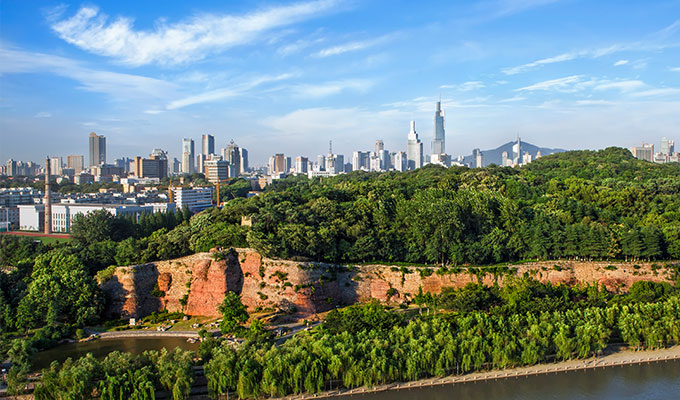A segment of the ancient city wall lies on the West side of Nanjing. Facing the Qinhuai River, this section of the city wall hosts many sites rich in historic and cultural value. Perhaps the oldest of them all, the Stone City Ruins, often becomes the subject of nostalgia and contemplation.
Amazed by the solemnity and melancholy of the city wall, numerous poets over the millennia have reminisced over the long history of Nanjing and the rise and fall of its dynasties, Touching the ancient, eroded bricks of the wall, even the most careless tourist could sense the heaviness of history within.
A great cliff, also known as the Ghost’s Face, stands sternly across the Qinhuai River to its west. The Yangtze once flowed under this great cliff, making it the perfect military lookout. In fact, the cliff was used as a military outpost during the reign of the Eastern Wu, dating back to the Three Kingdom period. It was considered a critical military location, and was used as bastion ever since. Over 20 metres tall, this part of the city wall is still formidable today.
Now decorated by hanging vines, the wall itself appears less intimidating. Long lost of its defensive purposes, the city wall still stands to remind us of old splendours. No longer guarded by vigilant soldiers, it offers a pleasant walk along the foot of the wall.
Walking up the river, one can ascend the wall through an ancient city gate. Although more recent construction of roads and bridges have caused the demolition of parts of the city wall, one can still walk on most parts of the city’s ancient heritage. Standing atop the wall, one is treated to a commanding view of the river, just as an ancient general one viewed.
On the east side of the wall is Qingliang Shan. Although it is, in effect, a small hill with lush vegetation, many ancient temples and pavilions are hidden within. Deep in a bamboo forest, the Qingliang Temple still welcomes pious followers. First built in the Southern Tang era, it records the rise of Buddhism in China a thousand years ago. The hill is a perfect resort for ancient Chinese scholars, providing a reclusive and undisturbed locale for their studies.
Walking down a winding path into the woods, and climbing up stone staircases, one can peek into the residences of scholars and their hermit lives. In addition, hidden in the woods was an academy for the study of Chinese classics, now converted into a museum for calligraphy and painting.
The refreshing forest air is a splendid change from its urban surroundings, and if one is lucky enough to visit on a snowy day, enjoy one of the most beautiful scenes in Nanjing, as claimed by old-hand travellers.
Taking a pleasant stroll along a mountain path is always a wonderful thing to do, but one need not travel far; it is right here, in the heart of urban Nanjing. Not to mention the rich historic and cultural elements, here to help one reflect on the city’s ancient past. It is time to step out, embrace nature, and take in everything Nanjing has to offer.











